Is it possible to clean a dishwasher with citric acid: pitfalls
Many housewives and quite a few craftsmen allow you to periodically clean your dishwasher using citric acid. It solves a number of problems and has almost no side effects, but you still need to use white crystals according to the instructions.
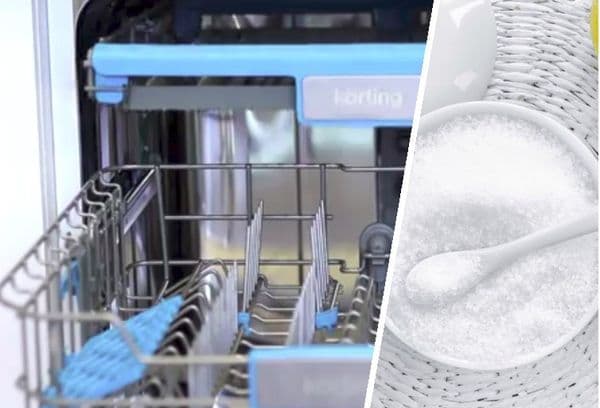
Where does dirt come from and how often to remove it?
Suffice it to remember the siphon and drain grate in the sink in those days when the PMM did not yet work in your kitchen. Despite the fact that water flowed regularly, the detergent solution got onto the walls, the sink became overgrown with grease, and the catcher (mesh or grate) became clogged with food debris. The same thing happens in the dishwasher.
The difference is that the device’s chamber is much larger, so it gets dirty noticeably slower. Still, the magazine purity-en.htgetrid.com recommends cleaning the drain filter after each dishwashing - then the procedure will take no more than a minute, and the catcher will always work well and will not become a breeding ground for bacteria and a source of stench.
In addition to dirt, the walls of the device are stained by salt deposits. A softener (mandatory in all regions with hard water) only partially solves the problem.
Lime deposits inevitably appear over time in narrow and poorly washed places:
- in the corners of the chamber and along the perimeter of the bottom and ceiling,
- from the inside at the ends of the watering cans,
- often - in pipes, watering cans, water supply hoses (first of all, rust from the water supply settles here).
Among other things, watering cans and supply pipes become clogged with remnants of PMM tablets. On short cycles and in warm water, many of them do not dissolve completely, and the particles gradually accumulate into an insoluble clog.
How often to clean
If in your city the water hardness is average and the softening salt in the pan is in normal volume, cleaning from lime and rust is needed once every 1.5-2 months.
How to use
Like any other cleaner, citric acid must be handled correctly, otherwise it will either have no effect or damage parts of the dishwasher.
Instructions:
- Turn off the machine and remove the trays - it is more convenient to wash them in the bath, immersing them halfway under water and using a brush or brush.
- Clean the PMM chamber and filters from grease and waste using a sponge and regular dish gel.
- Assemble and connect the device to the outlet strictly without dishes, so that the washed-out salts do not get on it.
- Pour citric acid into the tablet/detergent compartment.
- Run an hour-long cycle with moderately hot water.
- Turn on the washer with warm water to remove any remaining salts and product.
How many lemons to put in?
Experts recommend small portions. With a flow rate of 10 liters per cycle or less, 40 g of crystals is enough, with 11-13.9 liters - 50 g. If the machine pours out more than 14 liters of water - 60 g, but in any case no more than 75 g.
How to clean watering cans
After running the machine with citric acid and after rinsing, you will probably find something like white stones in the holes of the water cans, both upper and lower - these are the remains of limestone, pieces too large to fly out with streams of water during rinsing. They need to be removed.
The magazine purity-en.htgetrid.com categorically does not recommend cleaning injectors with toothpicks, matches or cotton swabs - they leave more garbage than good. At the slightest mistake, the wooden “tools” break off and remain in the watering can. In addition, neither toothpicks nor cotton swabs are able to pick up and pull up specks stuck in the watering can.
How to clean watering can nozzles
Use a thin plastic crochet hook, for example 0.75-1.5 mm. In principle, a metal tool will do, but you will have to act more carefully so as not to deform the plastic. If you don’t have the hook you need, bend it from medium-hard wire or press a notch on an aluminum / copper stick, no more than 2 mm in diameter.
The task is as follows:
- Turn the watering can with a light blow to force debris to get to the nozzles.
- Insert the hook into the hole at an angle, being careful not to widen the nozzle.
- Pull out or crush the debris using a hook.
- Remove dirt from the instrument, for example, with a clean cloth or just your fingers.
- Scroll the watering can with a click again - the remaining water will fly out, taking the crushed specks with it.
- Repeat the procedure about 3 times.
- It’s a good idea to rotate and check the nozzles after each dishwashing to make sure there are no noodles or other small food particles stuck there.
According to experience, fragments of toothpicks, food debris and even pieces of polyethylene from washing tablets are dug up in used PMM.
The easiest way
If the design of the watering can allows, remove it, disassemble it, remove large debris, soak it in a citric acid solution for 20-60 minutes, and then scrub with a soft brush. There is no need to dry it; you can immediately collect it and return it to the dishwasher.
Cleaning the camera
Citric acid quite successfully replaces many fat solvents. To wash the inner surface of the dishwasher chamber with the product, you need to prepare a concentrated solution or liquid slurry, apply it to a sponge, walk along the walls, floor, ceiling and joints, remove the excess with a clean damp cloth. Then run an hour-long cycle with warm water to rinse off the product.
Strong and dried stains, as well as mold, are well killed by the acid + alkali reaction. Distribute the crystals over the spots. Sprinkle regular table soda on top. Fill a spray bottle with clean water and spray the crystals and powder. Wait for the reaction to pass, then wipe with a clean, soft cloth soaked in water.
Advice
Use housekeeping gloves to protect your hands and manicure.
Is citric acid safe?
Citric acid is one of the safest for both humans and the device. The main thing is to maintain proportions and temperature.
How citric acid can harm you:
- in too large quantities and at a water temperature close to 100 degrees, the product can harm the skin of your hands, as well as rubber and plastic parts;
- When cleaning very old deposits with a concentrated hot solution, the deposits are separated into pieces that clog pipes, drains, and watering cans, and it is not always possible to crush these pieces.
How to avoid problems:
- Observe the dosage of crystals.
- Use hot, but not boiling water (50-60 degrees).
- Carry out cleaning in a timely manner, preventing the formation of a thick layer of plaque.
- Maintain softening salt levels at optimal levels.
- When cleaning old deposits, use the usual concentration of citric acid and water temperature so that the layers come off gradually and not all at once.
Benefits of Citric Acid
The product has many more advantages than disadvantages:
- It is environmentally friendly
- non-toxic,
- washes off easily,
- effective,
- acts comprehensively, corroding stone, lime, rust, grease, dirt and partially disinfecting,
- cheap,
- available,
- leaves a pleasant fresh aroma,
- does not cause allergies and does not harm PMM in moderate concentrations.
All this makes citric acid an excellent choice for regular cleaning of both the chamber walls and the inside of the machine. Take care of the device regularly, and it will not lose its effectiveness, and its service life will significantly extend.
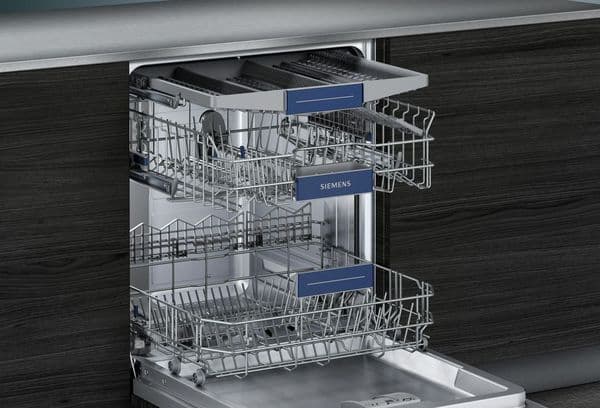
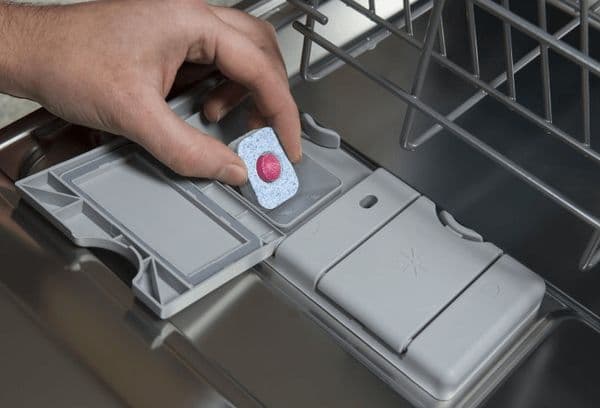
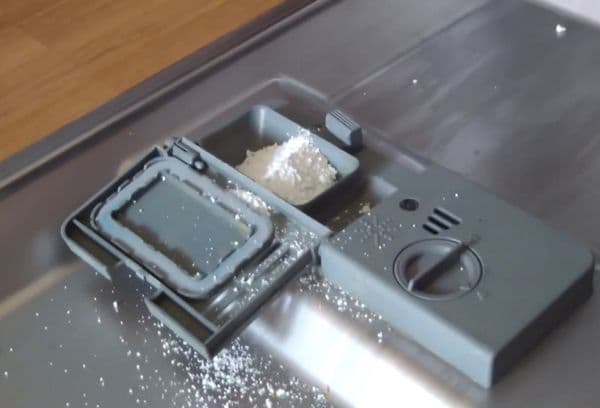

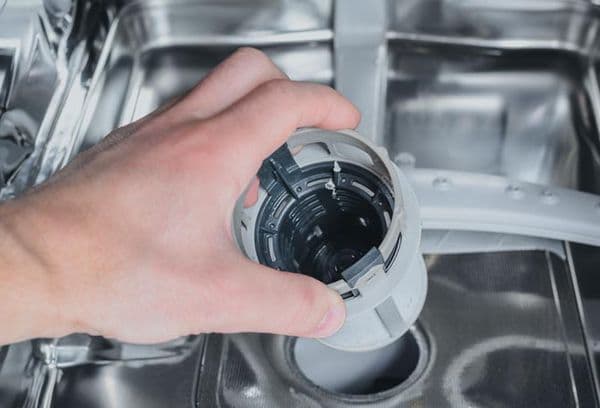
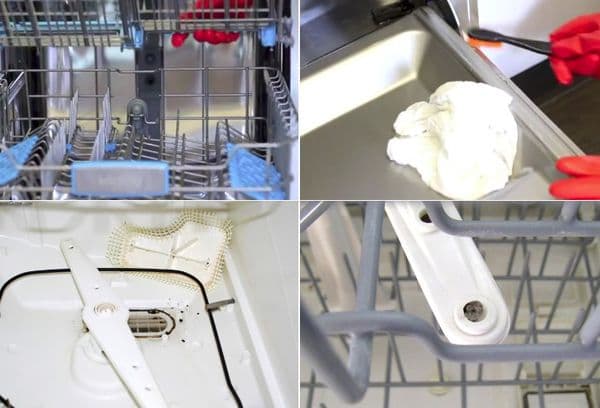
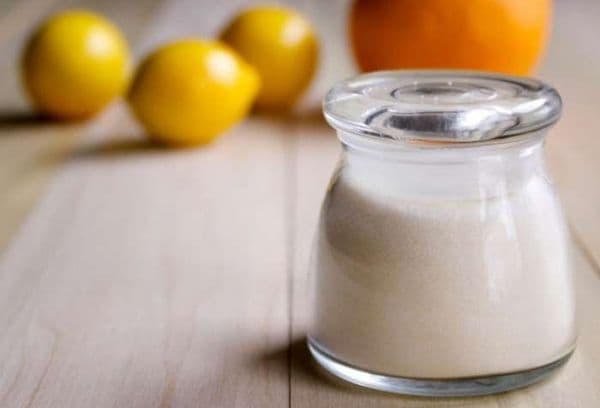
I washed the dishwasher as written in the article. Now she's like new! Citric acid washed everything well. And now there is a pleasant lemon smell from the machine.